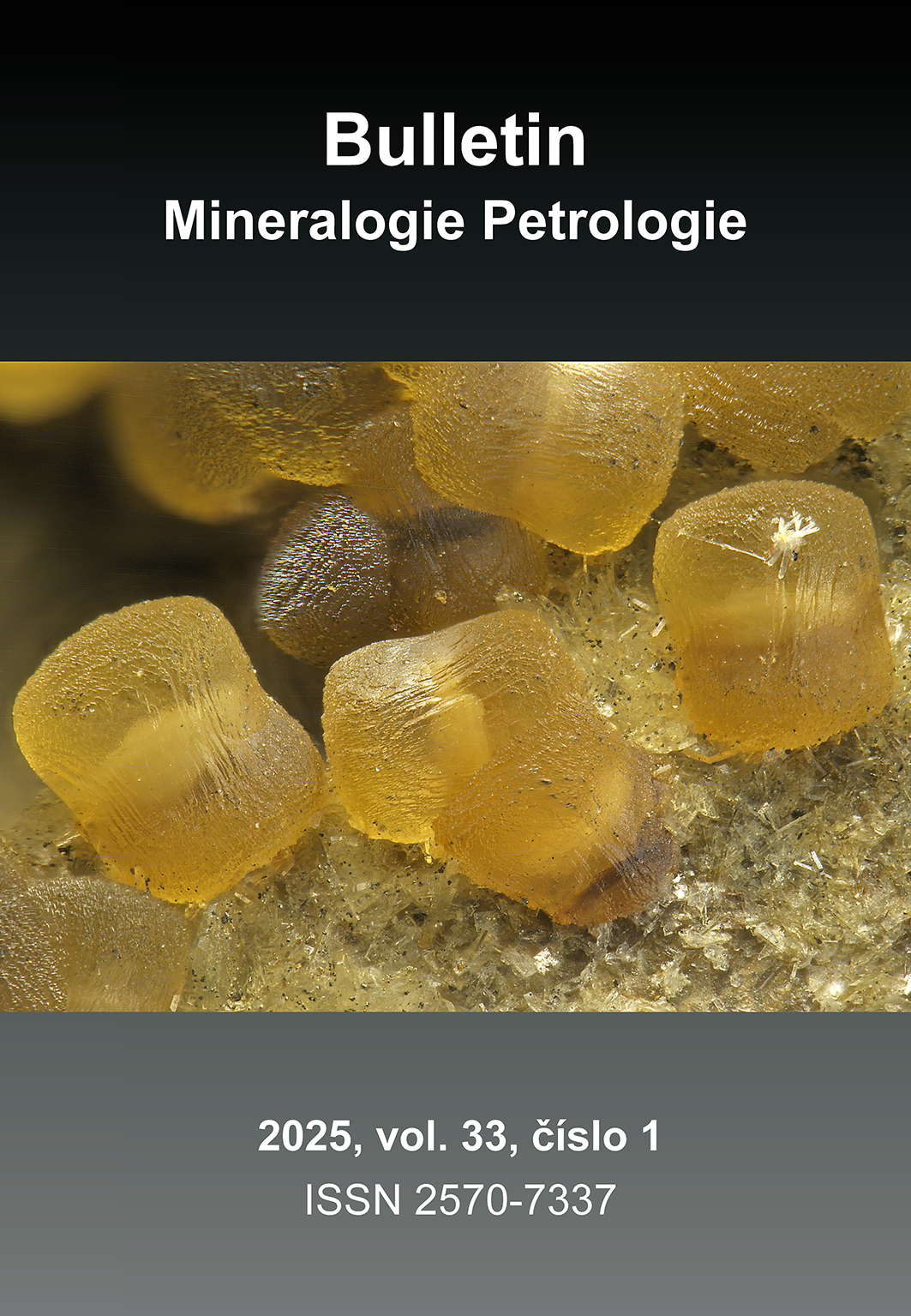Siderite concretion horizon above the No. 22 Coal Seam in the Upper Suchá Member of the Czech part of the Upper Silesian Basin
Keywords
Abstract
Siderite concretion horizons are known both from the paralic and terrestrial sediments of the Upper Silesian Basin. Significant horizon above the No. 22 Coal Seam in the Upper Suchá Member of Karviná Fm. (Westphalian, Pennsylvanian) was investigated by geological, mineralogical and geochemical methods. Horizon is developed virtually in the whole area of the Upper Suchá Member, where geological documentation is available. It is hosted by grey claystones in the direct roof of the No. 22 Seam, which belongs to the freshwater Faunistic Horizon Group Hubert. Shape of the concretions is mostly ellipsoidal and lensoidal, tabular ones are also present. Their size usually ranges between X0 cm and 1 m. Concretions do not have internal layering, warping of the claystone layering around them was observed. Typical feature of concretions is presence of septarian cracks. Matrix of the concretions is formed almost purely by two populations of non-zoned Mg-Ca or Mg-rich siderite with dispersed quartz, mica and accessory minerals similar to surrounding claystones, i.e. apatite, zircon, monazite and TiO2 minerals. Septarian fissures are filled by two generations of carbonate with predominant dolomitic composition and beef (fibrous) structure. Older one has dark brown colour, younger is white. Younger dolomite shows weak oscillatory zoning in BSE image caused by distribution of Fe-ions. Youngest fissure minerals are Mg-rich siderite, ankerite, calcite, quartz, baryte, apatite, halite, dickite and mineral from the chlorite group. Common sulphide minerals as pyrite, marcassite, chalcopyrite, sphalerite, galena, millerite and siegenite are also present, together with mineral phases from the vaesite-cattierite-pyrite series. The δ13C value of matrix siderite is +0.77 ‰ PDB and that of septarian dolomite -8.15 ‰ PDB, the δ18O value of matrix siderite is -11.25 ‰ PDB and that of septarian dolomite -9.79 ‰ PDB. Siderite matrix data shows fractionation during diagenetic processes, while fissure carbonate represents post-sedimentary hydrothermal product. Dolomite isotope data are comparable to those of hydrothermal carbonate mineralization of Early Carboniferous of the Nízký Jeseník Mts. We interpret concretion horizon as sediment of internal part of large-scale freshwater lake. Concretions are very probably syncompactional and develop by pervasive growth mechanism.
Files
References
Anthony J. W., Bideaux R. A., Bladh K. W., Nichols M. C. (eds.) (2003a) Handbook of Mineralogy. Vol. II, Silica, Silicates, Part I. 1-446, Mineral Data Publishing, Tuscon.
Anthony J. W., Bideaux R. A., Bladh K. W., Nichols M. C. (eds.) (2003b) Handbook of Mineralogy. Vol. V, Borates, Carbonates, Sulfates. 1-813, Mineral Data Publishing, Tuscon.
Aust J., ed. (1997) Odkrytá geologická mapa paleozoika české části hornoslezské pánve 1:100 000. Ministerstvo životního prostředí České republiky, Praha.
Curtis C. D., Coleman M. L., Love L. G. (1986) Pore water evolution during sediment burial from isotopic and mineral chemistry of calcite, dolomite and siderite concretions. Geochim. Cosmochim. Ac. 50, 2321-2334.
Dolníček Z., Lehotský T., Slobodník M., Hejtmánková E., Grígelová A., Zapletal J. (2014) Mineral-formning and diagenetic processes related to Tertiary hydrocarbon seepage at the Bohemian Massif/Outer Western Carpathians interface: Evidence from the Hrabůvka quarry, Moravia, Czech Republic. Mar. Petrol. Geol. 52, 77-92.
Dopita M. (1959) Jednotný způsob označení uhelných slojí v ostravsko-karvinském revíru. MS, Sdružení OKD, Ostrava.
Dopita M., ed. (1997a) Geologie české části hornoslezské pánve. 1-280, Ministerstvo životního prostředí České republiky, Praha.
Dopita M., Martinec P., Tomis L., Hoch I., Merenda M. (1997b) Karvinské souvrství. In: Dopita M. (ed.): Geologie české části hornoslezské pánve. 87-113. Ministerstvo životního prostředí České republiky, Praha.
Folprecht J. (1929) Sférosiderity. Sbor. Přírodověd. Společ. v Mor. Ostravě 5, 99-103.
Gabrhelová P. (2014) Pelokarbonátový horizont nad slojí 723 ve svrchních hrušovských vrstvách české části hornoslezské pánve. MS, diplomová práce, HGF VŠB-TU Ostrava.
Gaebler C. (1894) Über das Vorkommen von Kohleneisenstein in Oberschlesischen Steinkohlenflözen. Z. Berg- Hütten- u. Salinenwes. Preuss. St. 42, 157-162.
Havlena V. (1977) Namurská molasová etapa a středoevropské Variscikum z hlediska poměrů v hornoslezské pánvi. MS, Doktorská disertační práce, PřF UK Praha.
Havlena V. (1982) The namurian deposits of the upper Silesian coal basin. Rozpr. Čs. Akad. Věd, Ř. mat. přír. Věd 92, 1-79.
Hounslow M. W. (1997) Significance of localized pore pressure to the genesis of septarian concretions. Sedimentology 44, 1133-1147.
Jirásek J., Osovský M. (2012) Millerit a další minerály z pelosideritových konkrecí z dolu ČSA u Karviné (Česká republika). Acta Mus. Mor., Sci. geol. 92, 69-75.
Kotas A. (1995) Lithostratigraphy and sedimentologic -paleogeographic development - Upper Silesian Coal Basin. Prace Pan. Inst. geol. 148, 124-134.
Králík J. (1970) Mineralogy of carbonates from the coal seams of the Ostrava-Karviná district. Čas. Mineral. Geol. 15, 313-325.
Kučera J., Muchez P., Slobodník M., Prochaska W. (2010) Geochemistry of highly saline fluids in siliciclastic sequences: genetic implications for post-Variscan fluid flow in the Moravosilesian Palaeozoic of the Czech Republic. Int. J. Earth. Sci. 99, 269-284.
Losos Z., Hladíková J., Zimák J. (2001) Chemické a izotopické složení karbonátů z hydrotermálních žil v kulmu Nízkého Jeseníku a Oderských vrchů. Zpr. geol. Výzk. v Roce 2001, 154-156.
Osovský M., Pauliš P. (2013) Fluorapatit ze septáriových puklin pelokarbonátů svrchních sušských vrstev karvinského souvrství (česká část hornoslezské pánve). Minerál 21, 225-233.
Pratt B. R. (2001) Septarian concretions: internal cracking caused by synsedimentary earthquakes. Sedimento- logy 48, 189-213.
Raiswell R., Fisher Q. J. (2000) Mudrock-hosted carbo- nate concretions: a review of growth mechanisms and their influence on chemical and isotopic composition. J. Geol. Soc. London 157, 239-251.
Řehoř F., Řehořová M. (1972) Makrofauna uhlonosného karbonu československé části hornoslezské pánve. 1-136, Profil, Ostrava.
Sellés-Martínez J. (1996) Concretion morphology, classification and genesis. Earth-Sci. Rev. 41, 177-210.
Skoček V. (1961) Karbonátové konkrece v uhlonosných sedimentech Ostravsko-karvínské pánve. Sbor. Ústř. Úst. geol., Odd. geol. 28, 309-346.
Slavík F. (1926-1928) Nerosty karvinských sferosideritů. Sbor. Přírodověd. Společ. v Mor. Ostravě 4, 90-93.
Šusta V. (1932) Dva nové nerosty z karbonských sferosideritů ostravsko-karvinské oblasti. Věda přír. 13, 306-307.
Teichmüller M., Teichmüller R. (1985) Diagenesis of Coal (Coalification). In: Larsen G., Chilingar G. V. (ed.): Diagenesis in sediments and sedimentary rocks. 207-246. Elsevier, Amsterdam.
